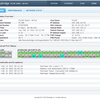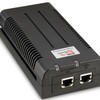In any case, the current PoE standard, IEEE 802.3af ratified back in 2003 only supports up to 13W (Type1) of power to the Powered Device (PD). The new standard called IEEE 802.3at supports up to 30W (Type2) of power to the PD or more than 2X the power from the old PoE standard. Besides the additional power (30W), Akros Silicon pointed out that 802.3at is improved over 802.3af in that it allows the PD to negotiate power to exactly the power that the PD needs. This results in better power management and low power consumption with superior "green emissions" over 802.3af.
Officially, the 802.3at standard won't be adopted until the end of 2008, however, Akros Silicon is heavily involved with the standards body and as such has insights to this new standard. It also allows Akros Silicon to be months ahead in developing products that support this new standard. In fact, Akros Silicon told me that the standard is stable enough that they feel they can launch a chipset today that will meet the 802.3at standard.
As such, today Akros Silicon is launching the industry's first 30W integrated Power Device Controller supporting 2-event Physical Layer Classification per the upcoming IEEE 802.3at specification. The AS1135 launched today is the successor to the AS11XX series of PD & DC-DC controllers. The 2-event Physical Layer Classification allows the PD to recognize whether it is connected to a Type 1 (802.3af/13W) or a Type 2 (802.3at/30W) Power Sourcing Equipment (PSE) and vice-versa. Thus, the 802.3at standard allow for legacy 802.3af devices to connect to 802.3at PSE switches and it will negotiate the specific port back to the old 13W specification.
Akros Silicon has also successfully completed testing the interoperability of the new AS1135 PD Controller with Microsemi's recently released PD64001 PSE Power Manager. Microsemi acquired PowerDsine, one of the leading PoE PSE products. For some background on PoE PSE switches and mid-spans, you can check out my 2005 TMC Labs review of the PowerDsine PD6024G & PD6548 midspans.
One other advantage of the additional power in the 802.3at standard is that it can be used to "trickle charge" laptops. While most laptops require 50-60W to full charge the battery, 30W is enough power to extend a laptop's battery charge from 2hrs to 8hrs or more. From personal experience, I hate taking my laptop to long meetings in the conference room since I also have to disconnect my laptop AC adaptor from my desk outlet and lug it to the conference room. Imagine instead I leave the AC adaptor where it is and instead connected a RJ45 cable to the network port on the laptop and it will "trickle charge" the laptop. I asked Akros Silicon which laptop vendors (Dell, Gateway, etc.) would be embedding PoE network interfaces into their upcoming laptops but Akros Silicon couldn't comment other than to say "big laptop companies are looking at that."
This past Friday I asked Amit Gattani, Director of Marketing for Akros Silicon, "There's no issues with the wires melting with this increased wattage in the wires, is there? Especially when these wires run up in the ceilings where it could post a fire hazard?"
Amit Gattani laughed and replied, "That's a very good question. At the standard level we spent a lot of time on this issue. Copper wire has a fairly high capability to carry current. However, heating of the cable, especially when these cables run in the attics and you're pulling 50 cables together in a bundle, heating of the cable can become an issue. One, 13W solutions you can use Cat 5 cable. For 30W it is Cat 5e and above and the reason is that Cat 5e and above have lower resistance drops so the heating issue is less." He added, "The 30W power limitation is actually put in place for a high degree of safety margin from the cable bundle heating up."
Another advantage of their chipset is that PDs using their chip-set can support both 48V and 12V. 12V is the most common consumer voltage used by AC wall adaptors because they are the cheapest on the market. PoE operates at 48V but Akros Silicon's technology actually steps down to 12V to allow connectivity to many consumer devices that have virtually standardized on 12V. Akros pointed out that many consumer devices are still shipping with AC adaptors, but eventually consumer devices will start to to use PoE exclusively to save on the costs of producing & shipping AC adaptors. Ironically, IP phones is the rare exception in the PoE world with its 48V requirement.
The new standard has a more sophisticated handshake protocol between the PSE and the PD and we are the first to implement that handshake protocol which enables better power management capabilities.
"Let's say I have an IP phone with a color LCD display, but it's onhook and the backlight it off. A call comes in and the backlight turns on increasing the total wattage. Does the IP phone negotiate the maximum wattage at the beginning and keeps it at that maximum wattage or does it negotiate on-the-fly as conditions change?"
Amit Gattani replied, "It can change on-the-fly. The previous standard it couldn't do that, but the new standard it can. But changing on-the-fly also means that now you are dependent on whether the PSE can supply that much power or not. That type of issue is left to the system software design. So you can negotiate up or down your power. At the physical layer is how much power is budgeted to the actual port."
I commented, "So if you're not using additional power, the PSE switch isn't going to send it anyway."
Amit Gattani replied, "Right. If you use only 4W then you'll get only 4W. Like you said, PSE won't send you anything more than that because you're only trying to draw what you draw. In any enterprise let's assume there are 50 phones with color LCDs. If every phone said I need 20W of power, the PSE that you would have to design would be way over specified. Because you won't have 50 phones in use at the same time, especially requiring 20W, so what will happen is the phone will come up, initially and say 'here's my maximum power need, but here's what I can work with it' in order to make phone calls, but you may not be able to use the video features and then based on that the PSE will allocate power. Instead of 20W x 50 phones which is 1000W, an IT Manager can deploy a 400W-600W PSE because he will know that not more than 20-30 phones will be calling at any given time. But you don't know which ports will need that power and that's where dynamic power allocation comes in."
Another new feature is the capability to externally set the switching frequency of the integrated DC-DC controller in the 100kHz - 500kHz range. This gives designers added flexibility to optimize the system for parameters like EMI, power consumption and component sizes. Lower switching frequencies can be beneficial in controlling EMI and improving no-load efficiency. Designers may also use higher switching frequencies to reduce the size of components used in the power converter output stage. These features are additions to standard features found in the AS1100 product family like integrated surge protection and low emissions DC-DC controller, to enable EMC ready system designs.
Summary of Features
The AS1135 is fully integrated and designed to provide the following features at a system level:
• Full support of the IEEE® Std. 802.3af-2005 and pre-standard IEEE® Std. 802.3at (Draft 2.0) power requirements
• Support of the 2-event Physical Layer Classification (per 802.3at Draft 2.0 standard), with hardware “AT-Detect” output
• Meets the IEC 61000-4-2/3/4/5/6 and IEC 60950 requirements for Surge, EMI and Isolation
• Integrated surge protection for board level surge meets > 15kV Air Discharge (IEC61000-4-2), > 8kV Contact Discharge (IEC61000-4-2) and > 6kV Surge (IEC61000-4-5)
• Integrated DC-DC converter with reduced EM emission for CISPR22/FCC part 15 Class B applications
• Programmable DC current limit up to 800mA
• Provides seamless support for local power down to 10V
• Programmable frequency 100kHz to 500kHz
• Low on resistance Hot Swap FET (0.8Ω typ)
• Over temperature protection
Pricing and Availability
Akros offers reference designs and evaluation boards to help evaluate the performance of the AS1135. The AS1135 is available in a 20-pin 5x5 QFN with a Reduction of Hazardous Substance (RoHS) compliant package. The device is priced at $1.66 for 1kU quantity.












